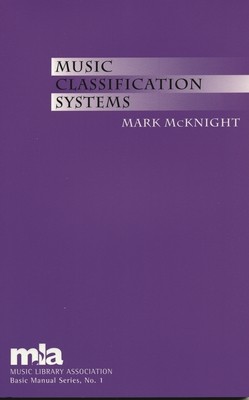
- We will send in 10–14 business days.
- Author: Mark McKnight
- Publisher: Scarecrow Press
- ISBN-10: 0810842637
- ISBN-13: 9780810842632
- Format: 14.5 x 21.5 x 1.4 cm, softcover
- Language: English
- SAVE -10% with code: EXTRA
Reviews
Description
Due to the distinctive nature of music as a separate "language" that non-musicians are often unable to read or understand, the cataloging and classification of music materials frequently present special challenges. In response to this often problematic situation, this volume is designed to introduce the principles of music classification to beginning music catalogers, as well as to non-specialist catalogers, and those who only occasionally deal with music materials. It will surely relieve the stress level for general catalogers by providing practical guidelines as well as clarifying and explaining the most commonly used classification systems in the United States-the Dewey Decimal Classification (DDC), the Library of Congress Classification (LCC), and the Alpha-Numeric System for Classification of Recordings (ANSCR). Also included is a general historical overview of music classification, from early attempts to organize specific collections, to the efforts of Oscar Sonneck and others to adapt fundamental principles of classification to the distinctive characteristics of music materials; as well as a discussion of the special needs of the users of those materials.
EXTRA 10 % discount with code: EXTRA
The promotion ends in 19d.17:26:53
The discount code is valid when purchasing from 10 €. Discounts do not stack.
- Author: Mark McKnight
- Publisher: Scarecrow Press
- ISBN-10: 0810842637
- ISBN-13: 9780810842632
- Format: 14.5 x 21.5 x 1.4 cm, softcover
- Language: English English
Due to the distinctive nature of music as a separate "language" that non-musicians are often unable to read or understand, the cataloging and classification of music materials frequently present special challenges. In response to this often problematic situation, this volume is designed to introduce the principles of music classification to beginning music catalogers, as well as to non-specialist catalogers, and those who only occasionally deal with music materials. It will surely relieve the stress level for general catalogers by providing practical guidelines as well as clarifying and explaining the most commonly used classification systems in the United States-the Dewey Decimal Classification (DDC), the Library of Congress Classification (LCC), and the Alpha-Numeric System for Classification of Recordings (ANSCR). Also included is a general historical overview of music classification, from early attempts to organize specific collections, to the efforts of Oscar Sonneck and others to adapt fundamental principles of classification to the distinctive characteristics of music materials; as well as a discussion of the special needs of the users of those materials.


Reviews